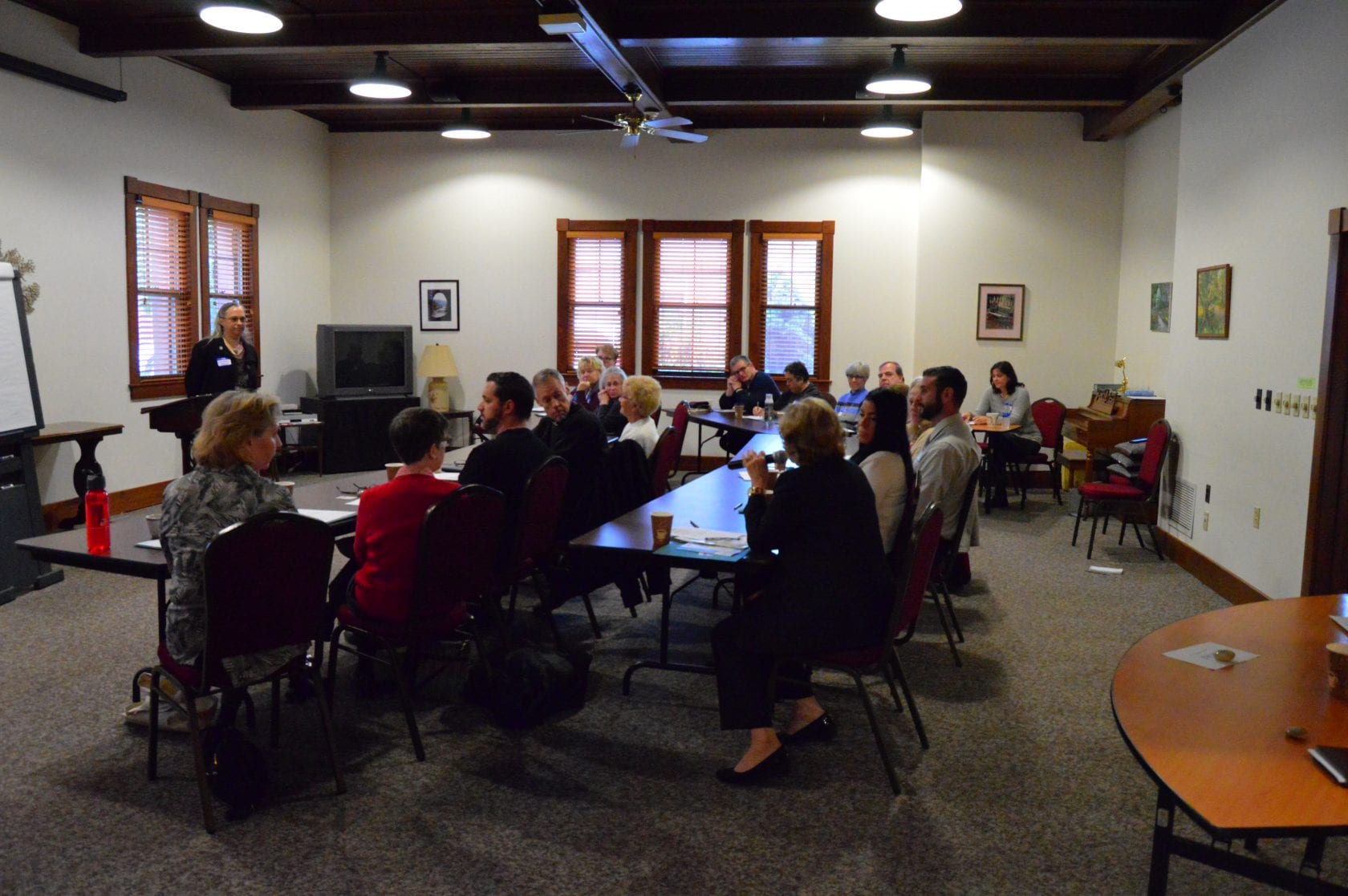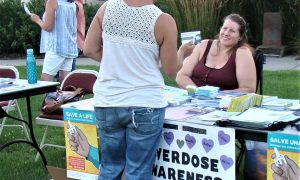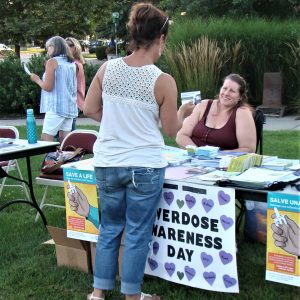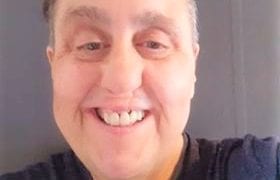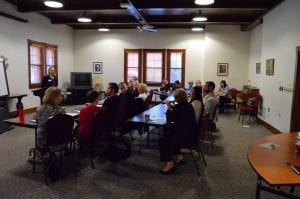
Recovering addicts and faith leaders gathered at the Genesis Spiritual Center (Photo by Peter Currier)
WESTFIELD- The Genesis Spiritual Life and Conference center held the ‘Walking with the Prodigal Child’ conference Tuesday morning.
The conference, which was sponsored by the Westfield Drug Task Force, was meant to foster discussion between church leaders regarding how to handle opiate addiction within their congregations.
The conference began with an opening prayer lead by Reverend Michael Hall of the Keene Unitarian Universalist Church.
“We gather this morning, hopeful and yet humbled, by what we see in our world, in our families, in our neighborhood, in our newspapers, those who are stumbling, those who are lost and looking for home,” says Hall in a part of his sermon.
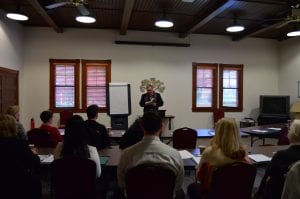
Reverend Michael Hall opens the conference with a prayer (Photo by Peter Currier)
Reverend Hall then introduced Mayor Brian Sullivan, who described his first introduction to the opioid crisis in his first months as Mayor.
“Three years ago I ran for my first term. My thoughts were that I was going to need to know about budgets, potholes, schools, and things like that,” says Mayor Sullivan, “within months of taking office, Westfield was hit with three overdose deaths. I did not know how to react. I didn’t know who to seek for help.”
Sullivan described how he approached his police chief, fire chief, the first responders and the Sheriffs department and asked what they need to do about this.
“Everyone’s answer was the same,” he says, “we need to talk about it.”
His first move was to create the Westfield Drug Task Force. “I didn’t want to just put together a task force that met quarterly and talked about, looked at statistics, and then moved on to only meet again next quarter,” says Sullivan, “We wanted to make a difference.”
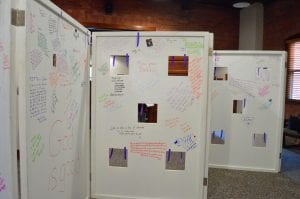
The wall of healing and hope stands at the ‘Walking with the Prodigal Child’ conference (Photo by Peter Currier)
Kathy Sitler, the head of the Westfield Drug Task Force, spoke after Mayor Sullivan about the task force and its history.
“I spent a lot of time talking with pastors of churches in this community, and they were struggling,” says Sitler, “They were burying people. You all were burying people in your congregations.”
Sitler turned the groups’ attention to ‘The Wall of Healing and Hope’, a wall that people can sign with messages of encouragement for those who are currently struggling or to honor a loved one who lost their battle to addiction.
The wall first appeared during the first annual candlelight vigil in Westfield on International Overdose Awareness Day on August 31st 2016.
“We wanted something tangible for people to take some time to reflect,” says Sitler, “As you can see, it’s filled with messages.”
This year, for the third annual candlelight vigil, 72 purple ribbons were added to the wall to represent the 72,000 people who died to overdose in the last year.
On some portions of the wall were ‘windows’ that looked through to the other side. “They are designed to give people hope,” says Sitler, “we wanted windows in that wall to offer hope to people that recovery is possible.”
Following Sitler’s remarks, attendees were given the opportunity to speak about why they were there and what they hoped to gain from the conference.
“I was shocked that Westfield, which seems like such a nice, quiet place, is struggling the way everyone else is,” says Reverend Barbara Hesse of the 2nd Congregational Church in Westfield, “I want to learn as much as I can.”
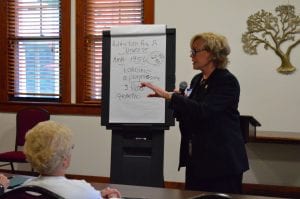
Joanne Burke helps the audience to define addiction as a disease (Photo by Peter Currier)
“I am here this morning for the one sentence that says, ‘what is addiction’” says Joanne Burke of the Hampden County Sheriffs Department.
Burke has been working with addiction through the Sheriffs Department for 27 years. She discussed ‘Section 35’, which is a Massachusetts law that allows the courts to involuntarily commit an individual who has a substance abuse problem if they reasonably believe that they are a danger to themselves or others.
“It’s a last ditch resource for someone that is living with an alcoholic or an addict,” says Burke.
Section 35 allows a judge to remand an individual even though they were not found to have committed a crime. The individual may be held at a treatment center for no longer than 90 days.
Burke had the attendees come up with a definition of ‘what is addiction’ as a group. The final consensus was that addiction is a chronic disease that will progressively get worse and, if left untreated, will be fatal. It also has a genetic component, as many addicts often see patterns of addiction run through their family.
“This is a little more scientific even though we’re in a spiritual surrounding,” says Burke, “The American Medical Association declared addiction a disease in 1956.”
Burke discussed a little bit of her own battles with alcoholism. “I am also in long term recovery,” she says, “it’s very difficult to wrap your head around the fact that this disease has progressed in me even though I’m not drinking.”
She describes how she has had people go back to drinking after over a decade sober. “They were back to not only where they were when they stopped, but worse,” she says.
Burke then described the most dangerous time to be an addict. “When a person comes out of jail or treatment they are much more likely to overdose,” she says. This is due to the person having the same amount of opiate receptors in their brain as when they were first incarcerated, but they don’t have the same tolerance they used to.
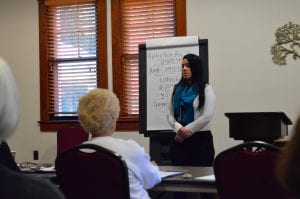
Amanda, a recovering addict, speaks about her experience with addiction and incarceration (Photo by Peter Currier)
Barbara Gallo, a correction counselor at the Hampden County Sheriffs Department, spoke about her experiences with addiction both at work and within her own family.
“It started for me at the ripe old age of 14,”says Gallo, “I have a sister who is an entire year and a day younger than me who began experimenting with drugs at that time.”
Gallo described how upsetting it was to see her little sister frequently come home high.
“I’ve been able to learn over a period of time that families take on roles,” she says, “because there’s a lot of chaos surrounding addiction inside a home. I have to agree that by the time you ask for help, things are pretty bad.”
Gallo touched upon the issue of enabling addicts and their behaviors and how her relationship with her sister shaped how she handles those around her with addiction issues.
“I felt I was wholly responsible for my sisters life. I felt like if I wasn’t taking care of her, she wasn’t going to make it,” she says, “It was a pretty heavy burden, and in doing so, I was part of the problem.”
Gallo says that she now has a much healthier relationship with her sister and her youngest son, who suffered from addiction and was sent to a recovery center under section 35.
One piece of advice Gallo gave to those who’s loved ones are suffering from addiction was to encourage peer support. She suggests having those who are addicted meet with those who have managed to achieve sobriety, suggesting it helps them see what the end goal looks like.
There were two attendees who are currently serving sentences related to their addictions.
Amanda, who declined to give her full name, is currently incarcerated at the Western Massachusetts Recovery and Wellness Center. She was present to tell her story of addiction and how she came to be incarcerated.
Amanda has been incarcerated for seven months, with about six more months remaining in her sentence.
“At 13 being home a lot by myself I was very independent,” says Amanda, “I thought I was an adult already who knew everything. I started doing what I wanted to do, leaving school early, and hanging out with the wrong crowd.”
Amanda’s mother, who went through alcoholism when Amanda was young, tried to save her from going down the same path. She put Amanda in a group home for people with addiction problems.
“I thought I was being a normal teenager doing normal teenager things,” says Amanda.
Amanda got her life in shape by the time she was 16 until she was 21, when she found herself having to leave an abusive relationship. She found herself going out and partying frequently to enjoy her new freedom away from abuse.
“I met another gentleman and he started using percocets,” she says. She eventually tried them and hated it.
He then moved on to oxycotin, which she also began experimenting with, slowly fine tuning the dosage until she found one that made her feel good and productive.
“I would feel pretty good, I was able to function, I was more productive. I was able to get my real estate license,” she describes, “before you know it I was addicted. I had to use every day or I felt sick.”
Amanda describes how she was arrested with the pills and did not need to do jail time, but was made to get sober, which she struggled with. After she gave birth to her second child, she was prescribed percocets for the pain, which were not working.
Her daughter’s father had already moved on to using heroin, which she eventually used to manage the pain of having just given birth while in the hospital. She was fully hooked on opiates again.
After a several year cycle of using and being clean, her significant other relapsed, and she decided joining him was easier than fighting him about it. After using every day for three years while working, her life seemed to be out of control.
Amanda was arrested for something she describes as out of character for herself. She got clean and has not used heroin in five years. But she thought she could at least drink alcohol.
Her drinking became a problem quickly, which lead to her relapsing with a different drug and failing a drug test. She finally had her suspended sentence handed down to her, which she is currently serving.
“Now I’m happy. I’ve surrendered everything and I’m free of alcohol and drugs,” she says in her final remarks.
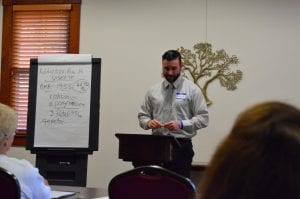
Adam Bartlett speaks about losing his job as a police officer to addiction (Photo by Peter Currier)
Adam Bartlett is a former police officer who was injured on the job. He was prescribed opiate-based medications to deal with the resulting pain. He lost his job and eventually found himself in jail because of his addictions.
Bartlett is a resident of the same recovery center as Amanda. He grew up in Huntington with 13 siblings. He was an athlete, his parents are still happily married, and there were no signs of addiction in the rest of his family. His background is not what one imagines when they think of addiction.
His first experience with drugs and alcohol came when his family moved down to Florida from Huntington when he was 14.
“I never really thought I had a problem,” says Bartlett, “It went from being intoxicated here and there to happening all the time.”
Bartlett then moved back to Massachusetts and realized that all his old friends had been involved in the same activities as him, so he fit right back in.
When Bartlett got older, he was accepted into the police academy. One day he was doing a leg workout when he injured his lower back with two herniated disks.
He got treatment and was taken care of by the academy. He stayed away from hard drugs for the time being. One day he was in pursuit of a suspect while on the job when he tripped on a pothole and reinjured his back, keeping him out of work for a while.
A woman he was seeing at the time directed him to a doctor that would give him percocets for the pain.
“I took one pill,” he says, “just like that I was hooked.”
It eventually spiraled to him taking a cocktail of painkillers to manage the pain that used to only require a single pill.
Bartlett was eventually called into his Chief’s office and was made to take a drug test by State Police. After submitting to the test, his Chief asked him to hand over his gun and badge, and he was informed that he was being suspended pending an investigation.
His only requirement to get his job back was to go to a detox center.
“Not me, I was too stubborn,” says Bartlett, “I told them to pay me this amount of money and you’re going to give me a recommendation and I’m going to walk out that door.”
After failing to hold another job, Bartlett found himself on his way to a pharmacy to get percocets with his significant other.
“The best thing to ever happen to me was when they put a gps tracker inside my car,” he says. He was pulled over but they let him go after being unable to prove anything. After being pulled over a second time, Bartlett found himself in a 66 mile pursuit on the highway, which ended with him trying to commit suicide by cop.
“I told them to tell my daughter I love her,” he says, “one of the officers told me to get on the ground and come with him, because I was going to tell her myself.”
Bartlett says that although he hated jail at first, it was the best thing to ever happen to him.
Both Bartlett and Amanda credit their faith with helping them move beyond their addictions.

